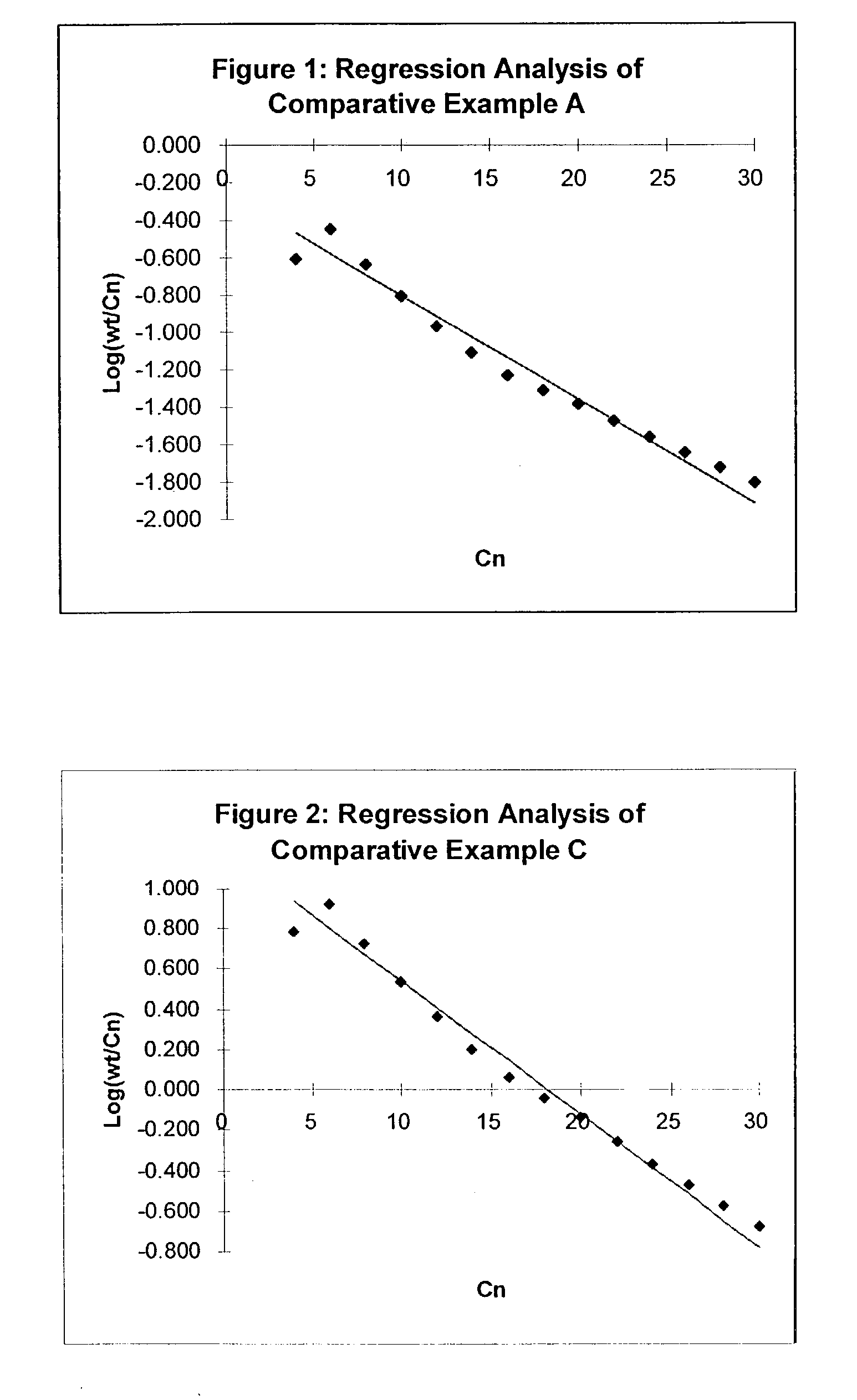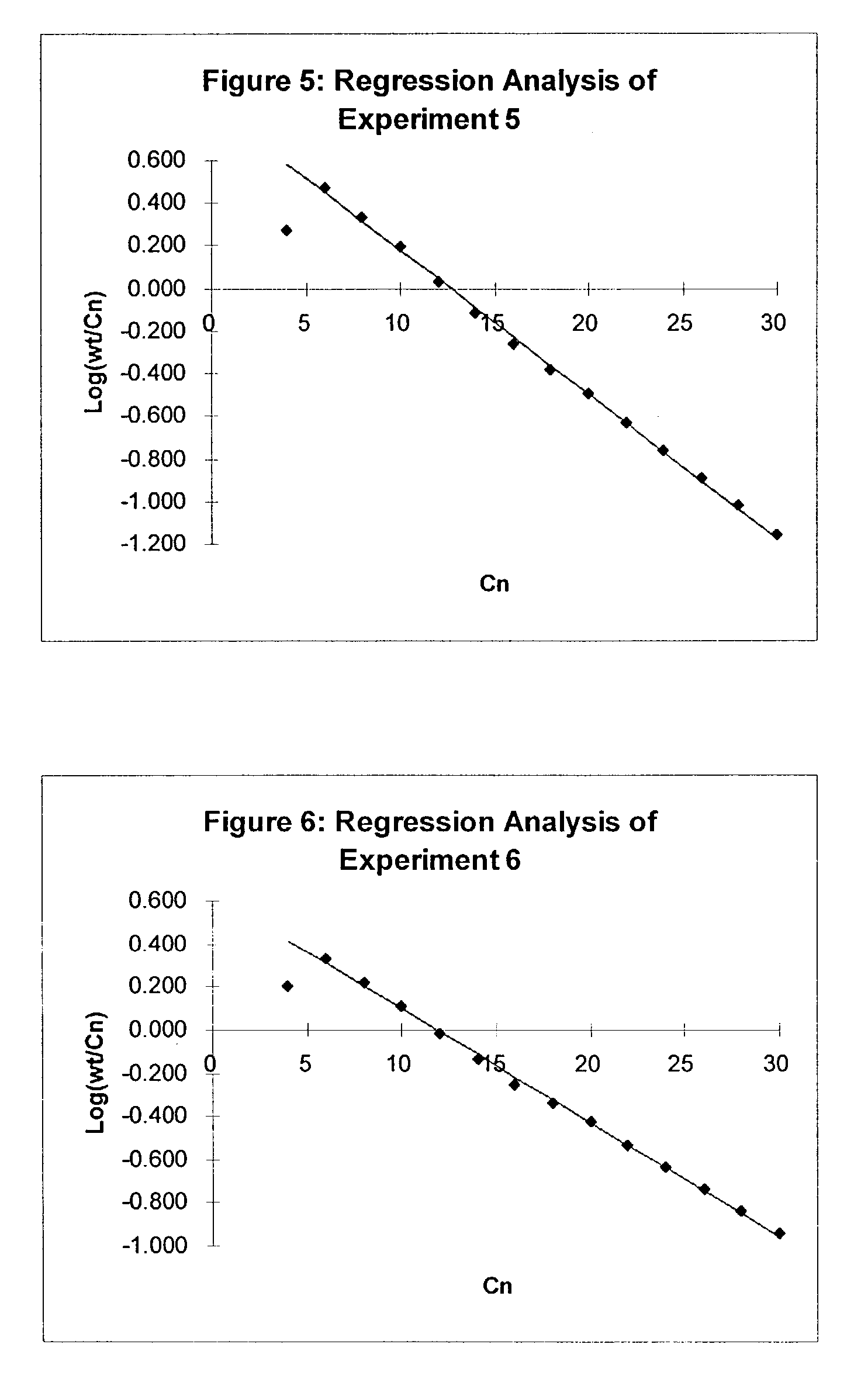Non-symmetrical ligands and catalyst systems thereof for ethylene oligomerization to linear alpha olefins
a technology of ethylene oligomerization and catalyst system, which is applied in the direction of hydrocarbons, chemical/physical processes, iron organic compounds, etc., can solve the problems of added cost, high cost, and inability to meet the requirements of ethylene oligomerization,
- Summary
- Abstract
- Description
- Claims
- Application Information
AI Technical Summary
Benefits of technology
Problems solved by technology
Method used
Image
Examples
example a (comparative)
[0114]Iron complex XI (prepared according to WO-A-99 / 02472) was employed in toluene in an experiment similar to Experiment Number 16 of WO-A-99 / 02472. The catalyst gave an oligomerisation mixture having a K-factor of 0.774, as derived from regression analysis using the C6–C28 contents, determined by GC. C4 is left out of the regression analysis, since its volatility hinders reliable GC-measurements. The details of Example A are given in Table 1. From this K-factor a C20–C28 fraction of 19.7% wt and a C30–C100 fraction of 12.2% wt on total product can be calculated. The amount of solids >C28 on total ethylene intake was 53.8% wt (the ethylene intake is assumed to be equal to the total oligomerisation product, i.e. C4–C100 olefins) This corroborates that the distribution deviates greatly from Schulz-Flory, giving rise to larger than expected amounts of higher molecular weight compounds, i.e. solid waxes. This deviation is also clear from FIG. 1 in which the regression analysis is repr...
example c (comparative)
[0116]Using the iron complex X in an experiment similar to Experiment number 13 of Table 1 of WO-A-99 / 02472, similar phenomena were observed (see comparative Example C in Table 1 for details). The amount of solids (having a carbon number >C28) isolated was 11.1% wt on total product, whilst on the basis of the K-factor of 0.737 (as derived from the C8–C28 contents by regression analysis) a C30–C100 fraction of 7.0% wt on total product has to be expected. Hence, a clear deviation from Schulz-Flory distribution, giving rise to a larger amount of high molecular weight compounds than calculated. The regression analysis using the C6–C28 contents, as given in FIG. 2 also shows a clear deviation from Schulz-Flory distribution at higher carbon numbers (for 12 observations R2=0.98 and standard error=0.06).
Experiments 1 and 2
[0117]Experiments 1 and 2 were carried out at an ethylene pressure of 1.6 MPa, i.e. 1.5 MPa (gauge), using the non-symmetrical iron complex (3) which is in accordance with...
experiment 3
[0119]Experiment 3 is a repeat of Experiments 1 and 2 at a lower ethylene intake and using a 0.5-liter steel autoclave at ethylene pressures of 1.6 MPa. Experimental details are mentioned in Table 1. Once again, regression analysis using the C6–C28 contents gives a nearly perfect Schulz-Flory distribution, having K-factor of 0.727 and the following regression statistics for 12 observations: R2=1.00 and standard error=0.02. The Schulz-Flory distribution is yet again confirmed by the isolated amount of waxy solids >C28, which is lower than the amounts calculated from the K-factor. A result of the lower final alpha olefin concentration, this Experiment has an even higher 1-dodecene purity of 98.6% wt in comparison with 98.1 and 98.0% wt for Experiments 1 and 2, respectively.
PUM
| Property | Measurement | Unit |
|---|---|---|
| Temperature | aaaaa | aaaaa |
| Temperature | aaaaa | aaaaa |
| Fraction | aaaaa | aaaaa |
Abstract
Description
Claims
Application Information
 Login to View More
Login to View More - R&D
- Intellectual Property
- Life Sciences
- Materials
- Tech Scout
- Unparalleled Data Quality
- Higher Quality Content
- 60% Fewer Hallucinations
Browse by: Latest US Patents, China's latest patents, Technical Efficacy Thesaurus, Application Domain, Technology Topic, Popular Technical Reports.
© 2025 PatSnap. All rights reserved.Legal|Privacy policy|Modern Slavery Act Transparency Statement|Sitemap|About US| Contact US: help@patsnap.com



